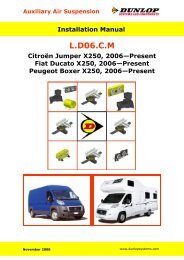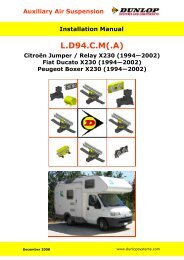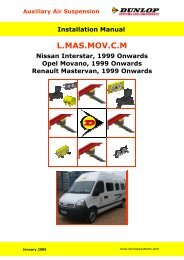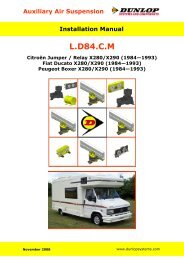INSTRUCTIONS MODE D'EMPLOI istruzioni d'uso ... - Marcle Leisure
INSTRUCTIONS MODE D'EMPLOI istruzioni d'uso ... - Marcle Leisure
INSTRUCTIONS MODE D'EMPLOI istruzioni d'uso ... - Marcle Leisure
Create successful ePaper yourself
Turn your PDF publications into a flip-book with our unique Google optimized e-Paper software.
FUNZIONAMENTODopo aver acceso il rivelatore tramite l’interruttore frontale (rif. 2) inizia la fase di riscaldamento delsensore che dura circa 90 secondi ed è segnalata dall’accensione della spia gialla (rif. 3).Al termine del riscaldamento il sensore è pronto per la segnalazione d’allarme. La condizione difunzionamento è segnalata dal lampeggio della spia gialla (rif. 3) con un lampeggio ogni 2 secondi.Quando la concentrazione di gas supera la soglia prevista, si attiva sia l’allarme acustico (buzzer consuono intermittente) che l’allarme visivo (led giallo sempre acceso).L’allarme rimarrà attivato finché il rivelatore non verrà spento e riacceso.DATI TECNICITensione di alimentazioneCorrente assorbita, tipicaCorrente assorbita, allarmeTemperatura di funzionamentoUmiditàTempo di riscaldamentoPotenza acusticaDurata sensoreDimensioni (mm)12 Vdc10 mA12 mA-10÷40 °C30÷95%90 sec.85 dB a 1 metro con buzzer esterno10 anni60x60x20 max4
++GBOVERVIEWThe LPG (liquid petroleum gas) and soporific gas detector, specially designed for the "caravaning" and"boating" sectors, can detect the presence of these gases in the air.This device has been specifically designed for the protection against ether (narcotic effect) and LPG.An audible alarm informs about the presence of gas in the air before it affects people inside thecompartment.The sensor signals the presence of LPG inside the compartment before its concentration reaches a tenthof the minimum level necessary to prime an explosion.The sensor has two different setting options that can be selected with the jumper placed on the back,which allow to modify the sensor's sensitivity according to the use and the installation position chosen.It may happen that the user shuts the sensor off because he is annoyed by the frequent or continuousalarms, which are apparently not justified. The correct behaviour is instead the immediate and abundantareation of the compartment and the resetting of the sensor by shutting it off and on again.Each detector is tested and set for the reference gas; the sensor life is of about 10 years from itsinstallation. After this period the detector must be replaced.WARNING:INSTALLATION AND CONNECTION- The detector must be perfectly installed by specialised technicians.- The incorrect use of the equipment invalidates the warranty and the manufacturerdeclines any responsibility for damage to things or persons.ENGLISH1BUZZERGAS-DETECTOR “LPG”M T G3REDBLACK–2O NWHITE(max 50 mA) S–12VPos. “A”Pos. “B”5
CONNECTIONThe equipment is supplied complete with connection cables of approx. 50 cm.Carefully observe the voltage required (12V), the polarity (black=negative; red=positive) and connect thedetector to a line protected by a fuse (1 - 3A).The white cable is an output (12V negative, max 50mA) for the connection of the external buzzer.INSTALLATIONIt is advisable that the installation is carried out by qualified technical personnel only, as the incorrectpositioning of the sensor may hamper its correct functioning and therefore jeopardize the health of peopleinside the compartment.USE AS LPG DETECTORThe jumper (rif. 1) must be set as in "pos. B"The LPG is heavier than air and will therefore concentrate at the bottom of the compartment; the detectorshall be placet about 20 to 40 cm from the floor in order to guarantee an effective functioning in the eventof gas leaks.USE AS LPG AND SOPORIFIC GAS DETECTORThe jumper (rif. 1) must be set as in "pos. A"The soporific gas (which is often used by burglars) is lighter than air and will therefore concentrate at thetop of the compartment; the detector shall be placed at eye-height, in the sleeping area of thecompartment.The installation near the kitchen is not advisable because of possibile false alarms due to cooking vaporsThe detector can be built-in or fixed to the wall with the spacer supplied.The module can be combined with other CBE and Truma modules to be completed with the installation offrames of the "Modular Plates" range.D=50 mmBuilt-in fixingWall-fixing6
FUNCTIONINGAfter having turned the detector on with the front button (ref. 2), the sensor's heating procedure lasts forabout 90 seconds and is indicated by the yellow led (ref.3).At the end of the heating procedure, the detector is ready to signal any alarming situation. The operatingmode is indicated by the flashing of the yellow (ref.3) (1 flash every 2 seconds).When the gas concentration exceeds the limit established, the acoustic (buzzer with intermittent sound)and visual (yellow led always on) alarm starts functioning.The alarm continues to operate until the detector is turned off.TECHNICAL SPECIFICATIONSInput voltageAbsorbed current, typicalAbsorbed current, alarmOperating temperatureHumidityHeating timeAcoustic powerDetector lifeDimensions (mm)12 Vdc10 mA12 mA-10÷40 °C30÷95%90 sec.85 dB at a distance of 1 metre with external buzzer10 years60x60x20 max7
++FGÉNÉRALITÉSLe détecteur de GPL (Gaz de pétrole liquéfié) et gaz soporifiques, spécifique pour le secteur du"camping-car" et "nautique", est en mesure de détecter la présence de ces gaz dans l'atmosphère.Cet appareil a été spécialement conçu pour la protection contre le gaz éthéré (effet narcotique) et le GPL.Un signal sonore signale la présence de gaz dans l'atmosphère, avant que celui-ci produise des effetssur les personnes à l'intérieur de l'habitacle.Le capteur signale la présence de GPL à l'intérieur de l'habitacle avant que sa concentration atteigne undixième de la valeur minimum nécessaire à déclencher une explosion.Il existe deux niveaux de réglage, sélectionnables à travers un pont de configuration (jumper) placé sur lederrière, qui permettent d'adapter la sensibilité du capteur en fonction de l'utilisation et de la positiond'installation choisie. Il peut arriver que l'utilisateur arrête le détecteur, parce qu'il est gêné par lessignalisations fréquentes et répétées, jugées à son avis injustifiées, alors que le bon comportement seraitune aération immédiate et abondante de l'habitacle et la remise en état du détecteur, suivie de son arrêtet de sa mise en marche successive.Chaque détecteur est testé et réglé en fonction du gaz de référence; la durée de vie du capteur estd'environ 10 ans à compter de la date d'installation. Après cette date, l'appareil doit être remplacé.INSTALLATION ET BRANCHEMENTIMPORTANT : - L'installation de cet appareil doit être effectuée dans les règles de l'art par destechniciens spécialisés.- En cas d'utilisation inappropriée de l'appareil, la garantie cesse d'avoir effet et lefabricant décline toute responsabilité en cas de préjudice porté aux personnes ouaux objets.1BUZZERGAS-DETECTOR “LPG”3M T GROUGENOIR–2O NBLANC(max 50 mA) S–12VPos. “A”Pos. “B”8
BRANCHEMENTA la livraison, l'appareil est équipé de câbles d'alimentation de 50 cm de long.Il est recommandé de respecter la tension d'alimentation (12V), la polarité (noir=négative; rouge=positive)et de brancher l'appareil à une ligne protégée par un fusible (1 - 3A).Le fil blanc est une sortie (12V négative, max. 50mA) pour le branchement du buzzer externe.INSTALLATIONLors de l'installation il est important de s'adresser à des techniciens spécialisés et compétents, car unmauvais positionnement du détecteur est susceptible de compromettre le bon fonctionnement et, donc,l'intégrité des personnes présentes à l'intérieur de l'habitacle.UTILISATION COMME DETECTEUR DE GPLLe pont de configuration (ref. 1) doit être réglé en "position B". Le gaz GPL est plus lourd que l'air il vadonc occuper la partie basse de l'atmosphère dans laquelle il se répand. C'est pourquoi, le détecteurdevra être placé à 20-40 cm du sol, afin d'assurer un bon fonctionnement de celui-ci en cas de présencede gaz.EMPLOI COMME DETECTEUR DE GAZ SOPORIFIQUE ET GPLLe pont de configuration (ref. 1) doit être réglé en "position A".Le gaz soporifique (souvent utilisé par les kidnappeurs) est moins lourd que l'air et il va donc occuper lapartie haute de l'atmosphère dans laquelle il se répand; le détecteur doit donc être placé à la hauteur desyeux, dans le secteur nocturne de l'habitacle.Son installation est déconseillée à proximité de la cuisine,afin d'éviter toutes fausses alarmes dues aux vapeurs de cuisson.L'installation peut se faire en mode "encastré" ou sur la paroi avec l'écarteur fourni avec l'appareil.Le module est réalisé pour être installé avec d'autres modules CBE et Truma pouvant être complétés pardes cadres de la série "Modular Plates".FRANÇAISD=50 mmFixation encastréeFixation murale9
FONCTIONNEMENTAprès avoir allumé le détecteur par l'interrupteur de face (rif. 2), la phase de réchauffage du capteur, qui dure90 secondes, est signalée par l'allumage du voyant jaune (réf. 3).Le réchauffage terminé, le capteur est prêt pour la signalisation d'alarme. La condition de fonctionnementest signalée par le voyant jaune clignotant (réf. 3) (1 clignotement toutes les 2 secondes).Quand la concentration de gaz dépasse le seuil prévu, l'alarme sonore (buzzer avec son intermittent) etvisuelle (LED jaune toujours allumée) se déclenche.L'alarme reste activée jusqu'à l'arrêt et à la remise en marche du détecteur.DONNEES TECHNIQUESTension d'alimentationCourant absorbé, typiqueCourant absorbé, alarmeTempérature de fonctionnementHumiditéTemps de réchauffagePuissance acoustiqueDurée capteurDimensions (mm)12 Vdc10 mA12 mA-10÷40 °C30÷95%60 sec.85 dB à 1 mètre avec buzzer externe10 ans60x60x20 max10
++DALLGEMEINE INFORMATIONENDas speziell für den Wohnmobil- und Nautikbereich entwickelte LPG- (Flüssiggas) undBetäubungsgaswarngerät ist in der Lage, das Vorhandensein dieser Gase in der Luft zu melden.Dieses Gerät wurde eigens für den Schutz vor Äthergas (Betäubungseffekt) und LPG konzipiert.Ein akustisches Signal meldet das Vorhandensein von Gas in der Luft, bevor dieses eine Wirkung auf diePersonen im Inneren des Fahrgastraums hat.Der Sensor zeigt das Vorhandensein von LPG im Fahrgastraum an, bevor die Konzentration im Innerendesselben ein Zehntel des zum Auslösen einer Explosion notwendigen Mindestwerts erreicht hat.Es gibt zwei Eichungsniveaus, die mittels einer Konfigurierungsbrücke (Jumper) auf der Rückseitewählbar sind und es erlauben, die Empfindlichkeit des Sensors dem Gebrauch und der gewähltenInstallationsposition anzupassen.Es kann passieren, dass der Verwender das Warngerät abschaltet, weil er sich durch häufige oderwiederholte Anzeigen gestört fühlt, die seiner Ansicht nach nicht gerechtfertigt sind. Das richtigeVerhalten ist hingegen ein sofortiges und reichliches Lüften des Fahrgastraums und die Rückstellungdes Warngeräts durch Aus- und Einschalten.Jeder Melder wird für das Bezugsgas getestet und kalibriert; die Lebensdauer des Sensors beträgt ca. 10Jahre ab dem Installationstermin. Nach dieser Zeit muss das Gerät ersetzt werden.INSTALLATION UND VERBINDUNGWICHTIG:- Die installation dieses Geräts muss fachgerecht durch einen Fachtechniker erfolgen.- Bei unpassendem Gebrauch der Ausrüstung verfällt die Garantie und der Herstellerlehnt jede Haftung für Sach-oder Personenschäden ab.1BUZZERGAS-DETECTOR “LPG”3M T GROTSCWARZ–2O NWEIß(max 50 mA) S–12VDEUTSCHPos. “A”Pos. “B”11
VERBINDUNGDas Gerät wird mit ca. 50 cm langen Versorgungskabeln ausgerüstet geliefert.Es wird empfohlen, die Versorgungsspannung (12V) sowie die Polarität (schwarz =negativ; rot=positiv)einzuhalten und das Gerät mit einer durch Sicherung (1 - 3A) geschützten Leitung zu verbinden.Der weiße Draht ist ein Ausgang (12V negativ, max. 50mA) für die Verbindung des externen Summers.INSTALLATIONWir erinnern daran, dass es bei der Installation opportun und empfehlenwert ist, sich an kompetentes,technisches Fachpersonal zu wenden, da eine falsche Positionierung des Warngeräts sein optimalesFunktionieren und damit die Unversehrtheit der im Inneren des Fahrgastraums anwesenden Personenbeeinträchtigen könnte.VERWENDUNG ALS LPG-WARNGERÄTDie Konfigurierungsbrücke (Bez. 1) muss wie in der "Position B" eingestellt werden.Das LPG-Gas ist schwerer als Luft und nimmt den unteren Teil der Umgebung, in der es ausströmt, ein,daher muss das Warngerät 20 ÷ 40 cm vom Boden positioniert werden, um ein wirkungsvolles Eingreifenbei Vorhandensein von Gas zu erhalten.VERWENDUNG ALS BETÄUBUNGSGAS- UND LPG-WARNGERÄTDie Konfigurierungsbrücke (Bez. 1) muss wie in der "Position A" eingestellt werden.Das Betäubungsgas (das oft von Räubern verwendet wird) ist leichter als Luft und nimmt den oberen Teilder Umgebung, in der es ausströmt, ein, daher muss das Warngerät in Augenhöhe im Schlafbereich desFahrgastraums positioniert werden.Von der Installation in der Nähe der Küche wird abgeraten, um falsche Alarme durch Kochdämpfe zuvermeiden.Die Installation kann per Einbau oder an der Wand mit dem beigelegten Distanzstück durchgeführtwerden.Das Modul ist für die Installation mit anderen CBE- und Truma-Modulen kombinierbar und mit derVerwendung von Rahmen der Serie "Modular Plates" zu vervollständigen.D=50 mmWandeinbauWandbefestigung12
BETRIEBNach dem Einschalten des Melders mittels des Schalters auf der Vorderseite (Bez. 2) beginnt dieAufheizphase des Sensors, die ca. 90 Sekunden dauert und durch das Angehen der gelbenKontrollleuchte (Bez. 3) gekennzeichnet ist.Am Ende des Aufheizens ist der Sensor für die Alarmanzeige bereit. Der Betriebszustand wird durch dasBlinken der gelben Kontrollleuchte angezeigt (Bez. 3) (1 Blinken alle 2 Sekunden).Wenn die Gaskonzentration die vorgesehene Schwelle überschreitet, werden der akustische Alarm(Summer mit unterbrechendem Ton) und der visuelle Alarm (gelbe Leuchtdiode immer an) aktiviert.Der Alarm bleibt aktiv bis der Melder abgeschaltet wird.TECHNISCHE DATENVersorgungsspannungAufgenommener Strom, typischAufgenommener Strom, AlarmBetriebstemparaturFeuchtigkeitAufheizzeitAkustische LeistungLebensdauer SensorAbmessungen12 Vdc10 mA12 mA-10÷40 °C30÷95%60 Sek.85 dB bei 1 Meter Entfernung mit externem Summer10 Jahremax. (mm) 60x60x2013
NOTE14
NOTE15
89/336 EMC73/23 e 93/68 EECI dati riportati nei fogli di <strong>istruzioni</strong> possono subire modifiche senza preavviso alcuno, questo è dovuto allecontinue migliorie tecniche. I disegni e i testi riprodotti sono proprietà della CBE. E' vietata la riproduzioneintegrale o parziale e la comunicazione a terzi senza l'autorizzazione scritta.Technical data on instructions sheets can be modified without notice, because technical improvementsare continually made. Design and texts are CBE property. Integral or partial reproductions are noadmitted as well as communications to third parties without written permission.Die in den Gebrauchsanweisungen wiedergegebenen Daten können ohne Vorankündigung geändertwerden, in Zusammenhang mit den technischen Verbesserungen. Die veröffentlichten Abbildungen undTexte sind Eigentum der Fa. CBE Jegliche Art von Vervielfältigung, komplett oder teilweise, ist ohneschriftliche Genehmigung untersagt.Les données figurant dans ce mode d'emploi peuvent subir des modifications sans aucun préavis enraison des améliorations techniques constantes. Les plans et textes reproduits ici sont la propriété deCBE. Faute d'autorisation écrite, la reproduction totale ou partielle, ainsi que la communication à detierces personnes, sont interdites.CBE ElettrotecnicaSpini di Gardolo, 116 - 38014 Gardolo (TN) - ItalyTel. +39 0461 991598 - Fax +39 0461 960009 - www.cbe.it - cbe@cbe.it
















